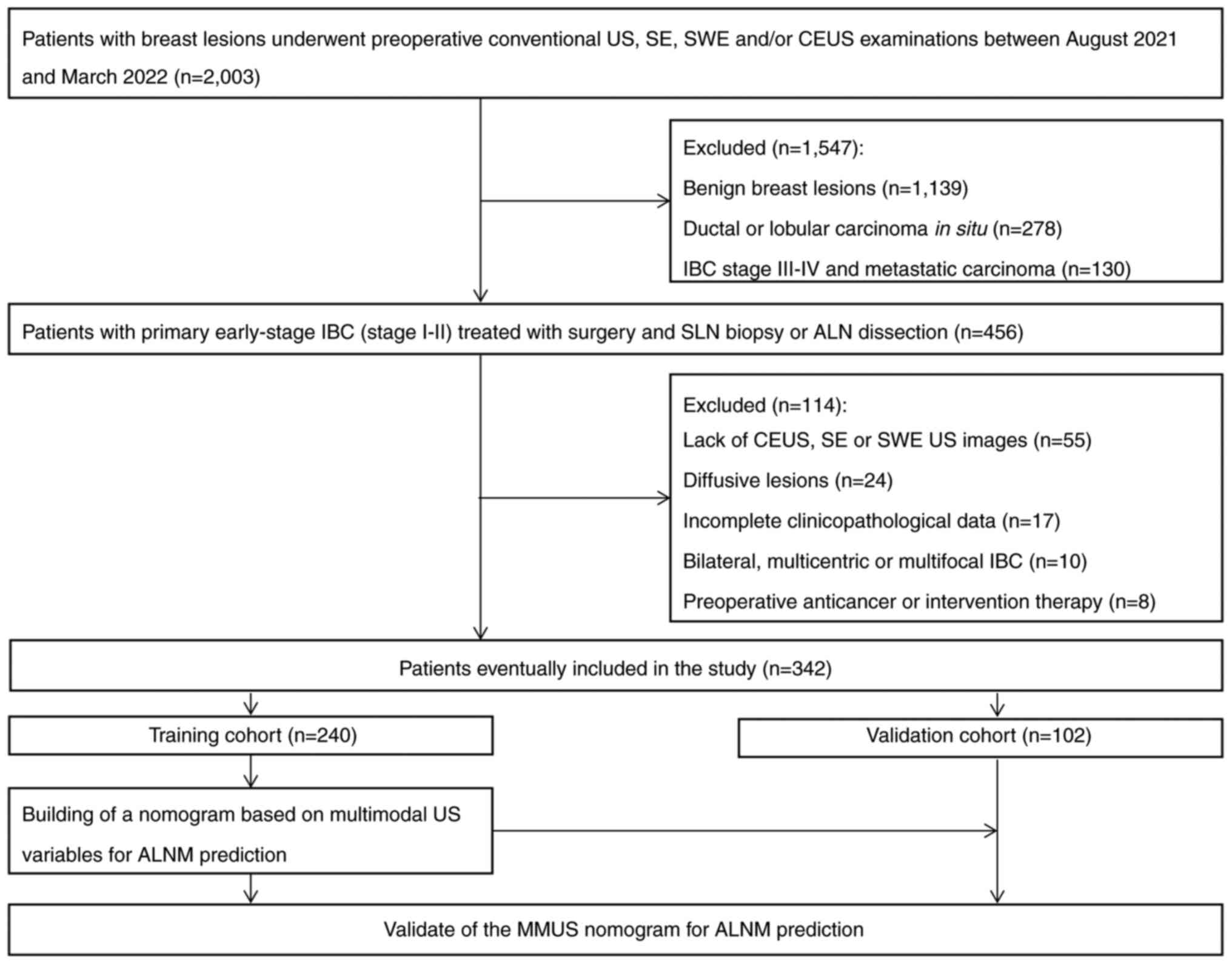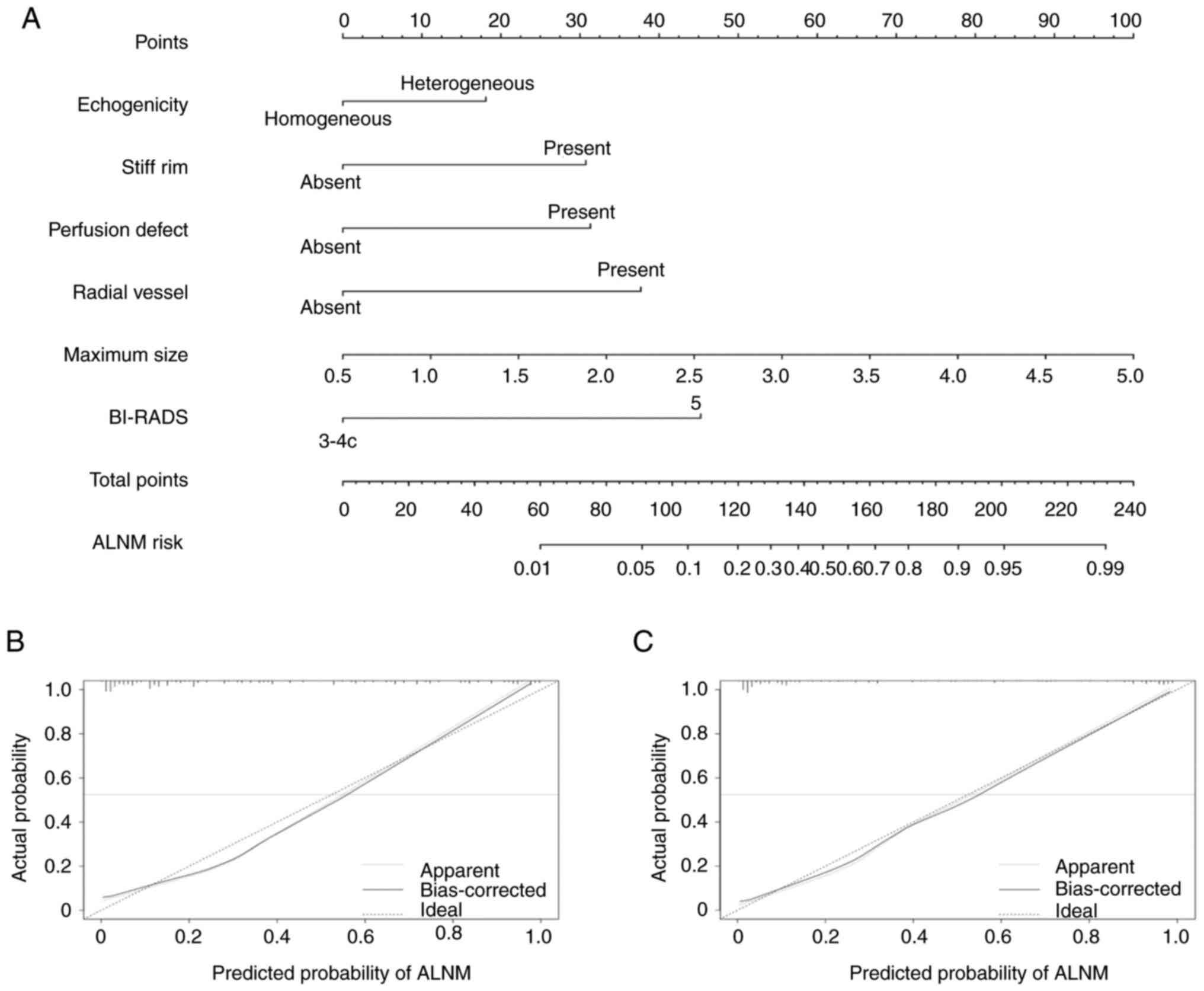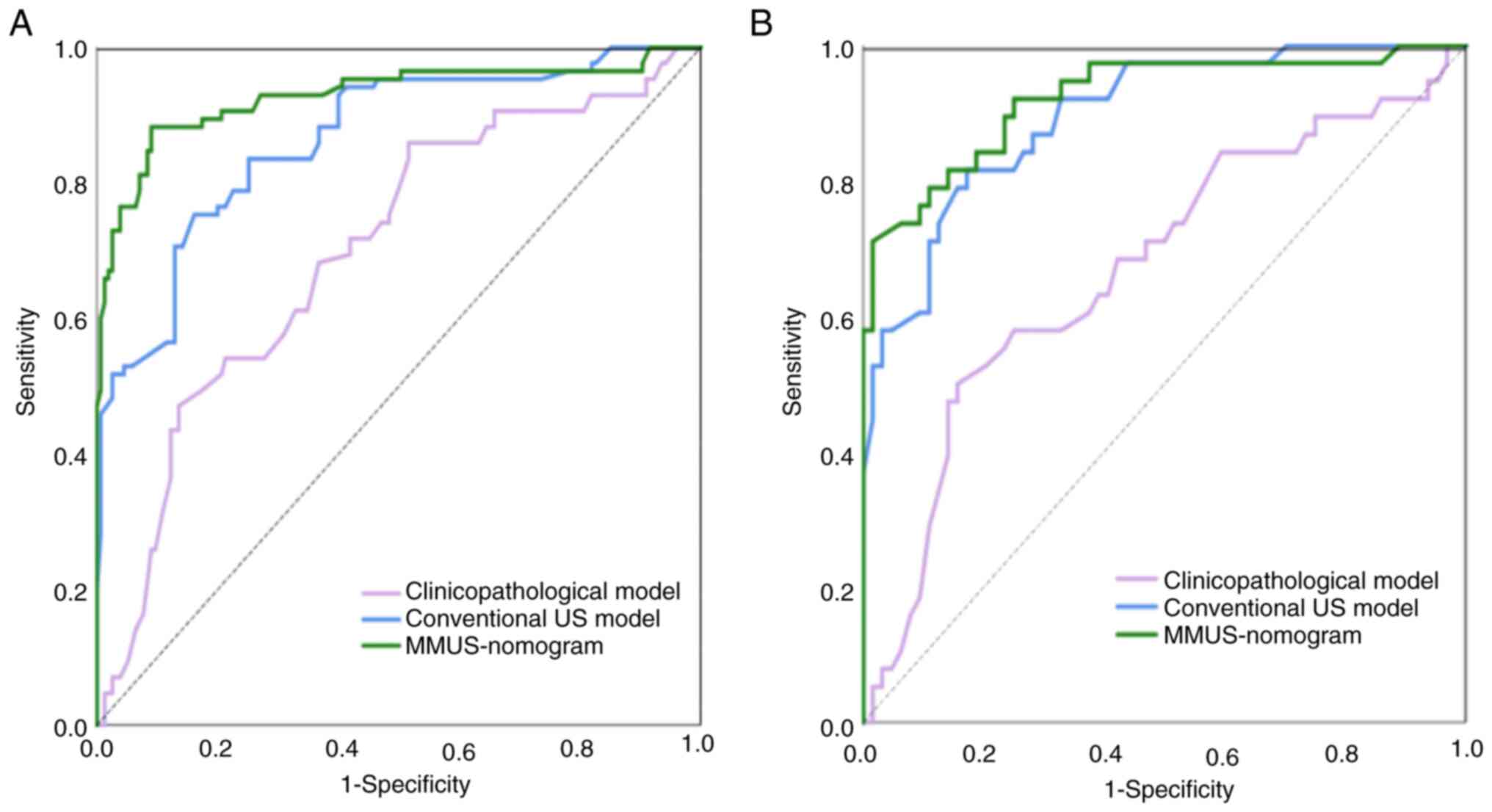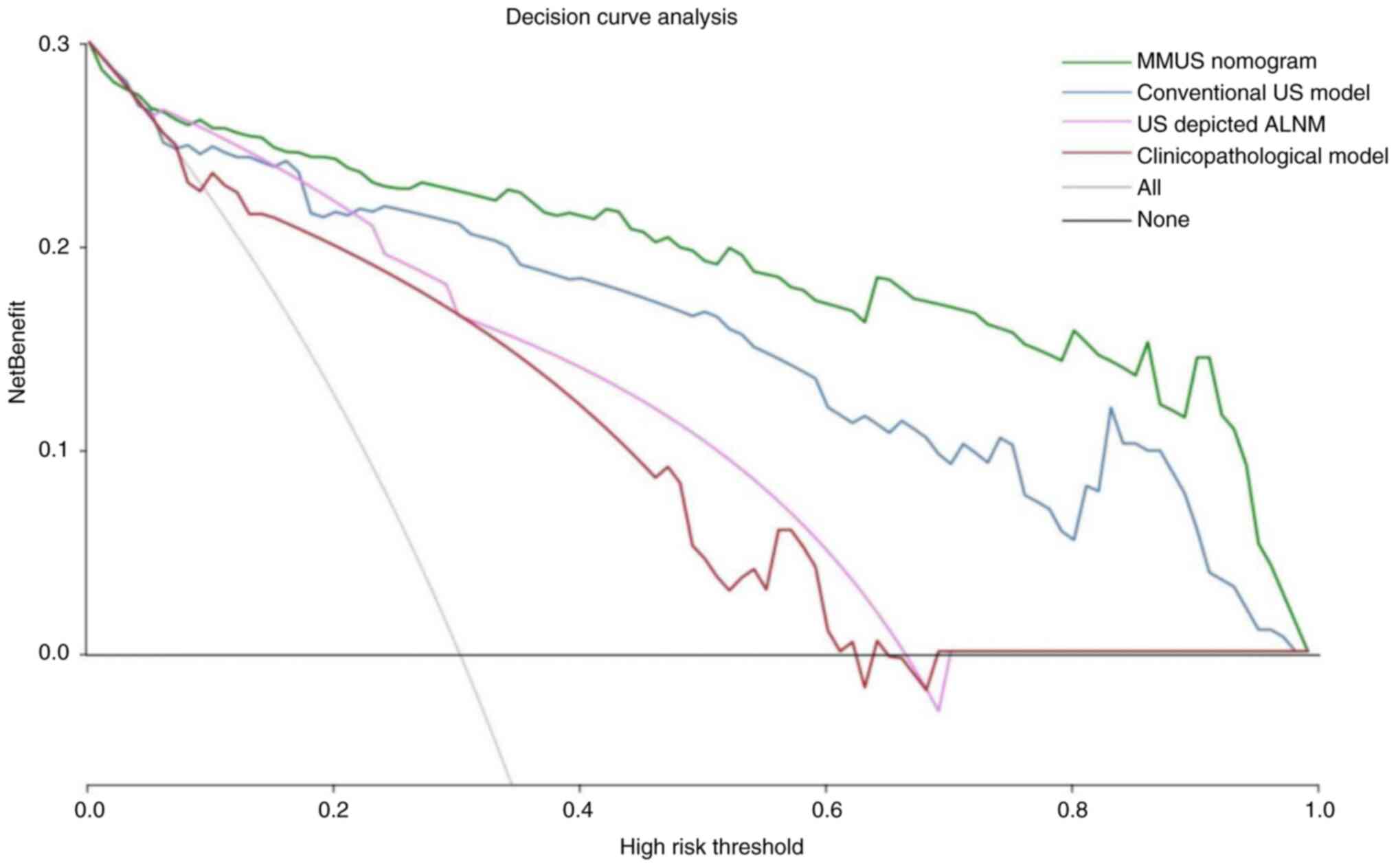|
1
|
Sung H, Ferlay J, Siegel RL, Laversanne M,
Soerjomataram I, Jemal A and Bray F: Global cancer statistics 2020:
GLOBOCAN estimates of incidence and mortality worldwide for 36
cancers in 185 countries. CA Cancer J Clin. 71:209–249. 2021.
View Article : Google Scholar : PubMed/NCBI
|
|
2
|
Giuliano AE, Ballman KV, McCall L, Beitsch
PD, Brennan MB, Kelemen PR, Ollila DW, Hansen NM, Whitworth PW,
Blumencranz PW, et al: Effect of axillary dissection vs. no
axillary dissection on 10-year overall survival among women with
invasive breast cancer and sentinel node metastasis: The ACOSOG
Z0011 (alliance) randomized clinical trial. JAMA. 318:918–926.
2017. View Article : Google Scholar : PubMed/NCBI
|
|
3
|
Lyman GH, Somerfield MR, Bosserman LD,
Perkins CL, Weaver DL and Giuliano AE: Sentinel lymph node biopsy
for patients with early-stage breast cancer: American society of
clinical oncology clinical practice guideline update. J Clin Oncol.
35:561–564. 2017. View Article : Google Scholar : PubMed/NCBI
|
|
4
|
Wilke LG, McCall LM, Posther KE, Whitworth
PW, Reintgen DS, Leitch AM, Gabram SG, Lucci A, Cox CE, Hunt KK, et
al: Surgical complications associated with sentinel lymph node
biopsy: Results from a prospective international cooperative group
trial. Ann Surg Oncol. 13:491–500. 2006. View Article : Google Scholar : PubMed/NCBI
|
|
5
|
Manca G, Rubello D, Tardelli E, Giammarile
F, Mazzarri S, Boni G, Chondrogiannis S, Marzola MC, Chiacchio S,
Ghilli M, et al: Sentinel lymph node biopsy in breast cancer:
Indications, contraindications, and controversies. Clin Nucl Med.
41:126–133. 2016. View Article : Google Scholar : PubMed/NCBI
|
|
6
|
Zhang YN, Wang CJ, Xu Y, Zhu QL, Zhou YD,
Zhang J, Mao F, Jiang YX and Sun Q: Sensitivity, specificity and
accuracy of ultrasound in diagnosis of breast cancer metastasis to
the axillary lymph nodes in Chinese patients. Ultrasound Med Biol.
41:1835–1841. 2015. View Article : Google Scholar : PubMed/NCBI
|
|
7
|
Hotton J, Salleron J, Henrot P, Buhler J,
Leufflen L, Rauch P and Marchal F: Pre-operative axillary
ultrasound with fine-needle aspiration cytology performance and
predictive factors of false negatives in axillary lymph node
involvement in early breast cancer. Breast Cancer Res Treat.
183:639–647. 2020. View Article : Google Scholar : PubMed/NCBI
|
|
8
|
Yu FH, Wang JX, Ye XH, Deng J, Hang J and
Yang B: Ultrasound-based radiomics nomogram: A potential biomarker
to predict axillary lymph node metastasis in early-stage invasive
breast cancer. Eur J Radiol. 119:1086582019. View Article : Google Scholar : PubMed/NCBI
|
|
9
|
Qiu X, Jiang Y, Zhao Q, Yan C, Huang M and
Jiang T: Could ultrasound-based radiomics noninvasively predict
axillary lymph node metastasis in breast cancer? J Ultrasound Med.
39:1897–1905. 2020. View Article : Google Scholar : PubMed/NCBI
|
|
10
|
Jiang M, Li CL, Luo XM, Chuan ZR, Chen RX,
Tang SC, Lv WZ, Cui XW and Dietrich CF: Radiomics model based on
shear-wave elastography in the assessment of axillary lymph node
status in early-stage breast cancer. Eur Radiol. 32:2313–2325.
2022. View Article : Google Scholar : PubMed/NCBI
|
|
11
|
Lee S, Jung Y and Bae Y: Clinical
application of a color map pattern on shear-wave elastography for
invasive breast cancer. Surg Oncol. 25:44–48. 2016. View Article : Google Scholar : PubMed/NCBI
|
|
12
|
Tozaki M and Fukuma E: Pattern
classification of ShearWave™ elastography images for differential
diagnosis between benign and malignant solid breast masses. Acta
Radiol. 52:1069–1075. 2011. View Article : Google Scholar : PubMed/NCBI
|
|
13
|
Evans A, Whelehan P, Thomson K, McLean D,
Brauer K, Purdie C, Baker L, Jordan L, Rauchhaus P and Thompson A:
Invasive breast cancer: Relationship between shear-wave
elastographic findings and histologic prognostic factors.
Radiology. 263:673–677. 2012. View Article : Google Scholar : PubMed/NCBI
|
|
14
|
Huang R, Lin Z, Dou H, Wang J, Miao J,
Zhou G, Jia X, Xu W, Mei Z, Dong Y, et al: AW3M: An auto-weighting
and recovery framework for breast cancer diagnosis using
multi-modal ultrasound. Med Image Anal. 72:1021372021. View Article : Google Scholar : PubMed/NCBI
|
|
15
|
Zheng X, Yao Z, Huang Y, Yu Y, Wang Y, Liu
Y, Mao R, Li F, Xiao Y, Wang Y, et al: Deep learning radiomics can
predict axillary lymph node status in early-stage breast cancer. J
Nat Commun. 11:12362020. View Article : Google Scholar : PubMed/NCBI
|
|
16
|
Guo X, Liu Z, Sun C, Zhang L, Wang Y, Li
Z, Shi J, Wu T, Cui H, Zhang J, et al: Deep learning radiomics of
ultrasonography: Identifying the risk of axillary non-sentinel
lymph node involvement in primary breast cancer. EBioMedicine.
60:1030182020. View Article : Google Scholar : PubMed/NCBI
|
|
17
|
Liu D, Wu J, Lin C, Ding S, Lu S, Fang Y,
Huang J, Hong J, Gao W, Zhu S, et al: The comparative safety of
epirubicin and cyclophosphamide versus docetaxel and
cyclophosphamide in lymph node-negative, HR-positive, HER2-negative
breast cancer (ELEGANT): A randomized trial. Cancers (Basel).
14:32212022. View Article : Google Scholar : PubMed/NCBI
|
|
18
|
Collins GS, Reitsma JB, Altman DG and
Moons KG: Transparent reporting of a multivariable prediction model
for individual prognosis or diagnosis (TRIPOD): The TRIPOD
statement. Br J Surg. 102:148–158. 2015. View Article : Google Scholar : PubMed/NCBI
|
|
19
|
Penault-Llorca F, André F, Sagan C,
Lacroix-Triki M, Denoux Y, Verriele V, Jacquemier J, Baranzelli MC,
Bibeau F, Antoine M, et al: Ki67 expression and docetaxel efficacy
in patients with estrogen receptor-positive breast cancer. J Clin
Oncol. 27:2809–2815. 2009. View Article : Google Scholar : PubMed/NCBI
|
|
20
|
Coates AS, Winer EP, Goldhirsch A, Gelber
RD, Gnant M, Piccart-Gebhart M, Thürlimann B and Senn HJ; Panel
Members, : Tailoring therapies-improving the management of early
breast cancer: St Gallen international expert consensus on the
primary therapy of early breast cancer 2015. Ann Oncol.
26:1533–1546. 2015. View Article : Google Scholar : PubMed/NCBI
|
|
21
|
Mercado CL: BI-RADS update. Radiol Clin
North Am. 52:481–487. 2014. View Article : Google Scholar : PubMed/NCBI
|
|
22
|
Bedi DG, Krishnamurthy R, Krishnamurthy S,
Edeiken BS, Le-Petross H, Fornage BD, Bassett RL Jr and Hunt KK:
Cortical morphologic features of axillary lymph nodes as a
predictor of metastasis in breast cancer: In vitro sonographic
study. AJR Am J Roentgenol. 191:646–652. 2008. View Article : Google Scholar : PubMed/NCBI
|
|
23
|
Koelliker SL, Chung MA, Mainiero MB,
Steinhoff MM and Cady B: Axillary lymph nodes: US-guided
fine-needle aspiration for initial staging of breast
cancer-correlation with primary tumor size. Radiology. 246:81–89.
2008. View Article : Google Scholar : PubMed/NCBI
|
|
24
|
Itoh A, Ueno E, Tohno E, Kamma H,
Takahashi H, Shiina T, Yamakawa M and Matsumura T: Breast disease:
Clinical application of US elastography for diagnosis. Radiology.
239:341–350. 2006. View Article : Google Scholar : PubMed/NCBI
|
|
25
|
Zhou J, Zhan W, Chang C, Zhang X, Jia Y,
Dong Y, Zhou C, Sun J and Grant EG: Breast lesions: Evaluation with
shear wave elastography, with special emphasis on the ‘stiff rim’
sign. Radiology. 272:63–72. 2014. View Article : Google Scholar : PubMed/NCBI
|
|
26
|
Sidhu PS, Cantisani V, Dietrich CF, Gilja
OH, Saftoiu A, Bartels E, Bertolotto M, Calliada F, Clevert DA,
Cosgrove D, et al: The EFSUMB guidelines and recommendations for
the clinical practice of contrast-enhanced ultrasound (CEUS) in
non-hepatic applications: Update 2017 (long version). Ultraschall
Med. 39:e2–e44. 2018. View Article : Google Scholar : PubMed/NCBI
|
|
27
|
Li H, Jun Z, Zhi-Cheng G and Xiang Q:
Factors that affect the false negative rate of sentinel lymph node
mapping with methylene blue dye alone in breast cancer. J Int Med
Res. 47:4841–4853. 2019. View Article : Google Scholar : PubMed/NCBI
|
|
28
|
Pesek S, Ashikaga T, Krag LE and Krag D:
The false-negative rate of sentinel node biopsy in patients with
breast cancer: A meta-analysis. World J Surg. 36:2239–2251. 2012.
View Article : Google Scholar : PubMed/NCBI
|
|
29
|
Fang J, Zhao W, Li Q, Zhang B, Pu C and
Wang H: Correlation analysis of conventional ultrasound
characteristics and strain elastography with ki-67 status in breast
cancer. Ultrasound Med Biol. 46:2972–2978. 2020. View Article : Google Scholar : PubMed/NCBI
|
|
30
|
Wan CF, Du J, Fang H, Li FH, Zhu JS and
Liu Q: Enhancement patterns and parameters of breast cancers at
contrast-enhanced US: Correlation with prognostic factors.
Radiology. 262:450–459. 2012. View Article : Google Scholar : PubMed/NCBI
|
|
31
|
Zhu AQ, Li XL, An LW, Guo LH, Fu HJ, Sun
LP and Xu HX: Predicting axillary lymph node metastasis in patients
with breast invasive ductal carcinoma with negative axillary
ultrasound results using conventional ultrasound and
contrast-enhanced ultrasound. J Ultrasound Med. 39:2059–2070. 2020.
View Article : Google Scholar : PubMed/NCBI
|
|
32
|
Bevilacqua JL, Kattan MW, Fey JV, Cody HS
III, Borgen PI and Van Zee KJ: Doctor, what are my chances of
having a positive sentinel node? A validated nomogram for risk
estimation. J Clin Oncol. 25:3670–3679. 2007. View Article : Google Scholar : PubMed/NCBI
|
|
33
|
Yoshihara E, Smeets A, Laenen A, Reynders
A, Soens J, Van Ongeval C, Moerman P, Paridaens R, Wildiers H,
Neven P and Christiaens MR: Predictors of axillary lymph node
metastases in early breast cancer and their applicability in
clinical practice. Breast. 22:357–361. 2013. View Article : Google Scholar : PubMed/NCBI
|
|
34
|
Xiong J, Zuo W, Wu Y, Wang X, Li W, Wang
Q, Zhou H, Xie M and Qin X: Ultrasonography and clinicopathological
features of breast cancer in predicting axillary lymph node
metastases. BMC Cancer. 22:11552022. View Article : Google Scholar : PubMed/NCBI
|
|
35
|
Yu Y, Tan Y, Xie C, Hu Q, Ouyang J, Chen
Y, Gu Y, Li A, Lu N, He Z, et al: Development and validation of a
preoperative magnetic resonance imaging radiomics-based signature
to predict axillary lymph node metastasis and disease-free survival
in patients with early-stage breast cancer. JAMA Netw Open.
3:e20280862020. View Article : Google Scholar : PubMed/NCBI
|
|
36
|
Dong Y, Feng Q, Yang W, Lu Z, Deng C,
Zhang L, Lian Z, Liu J, Luo X, Pei S, et al: Preoperative
prediction of sentinel lymph node metastasis in breast cancer based
on radiomics of T2-weighted fat-suppression and diffusion-weighted
MRI. Eur Radiol. 28:582–591. 2018. View Article : Google Scholar : PubMed/NCBI
|
|
37
|
Fujii T, Yajima R, Tatsuki H, Suto T,
Morita H, Tsutsumi S and Kuwano H: Significance of lymphatic
invasion combined with size of primary tumor for predicting
sentinel lymph node metastasis in patients with breast cancer.
Anticancer Res. 35:3581–3584. 2015.PubMed/NCBI
|
|
38
|
Auvinen P, Tammi R, Parkkinen J, Tammi M,
Agren U, Johansson R, Hirvikoski P, Eskelinen M and Kosma VM:
Hyaluronan in peritumoral stroma and malignant cells associates
with breast cancer spreading and predicts survival. Am J Pathol.
156:529–536. 2000. View Article : Google Scholar : PubMed/NCBI
|
|
39
|
Bae MS, Shin SU, Song SE, Ryu HS, Han W
and Moon WK: Association between US features of primary tumor and
axillary lymph node metastasis in patients with clinical T1-T2N0
breast cancer. Acta Radiol. 59:402–408. 2018. View Article : Google Scholar : PubMed/NCBI
|
|
40
|
Sheng DL, Shen XG, Shi ZT, Chang C and Li
JW: Survival outcome assessment for triple-negative breast cancer:
A nomogram analysis based on integrated clinicopathological,
sonographic, and mammographic characteristics. Eur Radiol.
32:6575–6587. 2022. View Article : Google Scholar : PubMed/NCBI
|
|
41
|
Zhang H, Dong Y, Jia X, Zhang J, Li Z,
Chuan Z, Xu Y, Hu B, Huang Y, Chang C, et al: Comprehensive risk
system based on shear wave elastography and BI-RADS categories in
assessing axillary lymph node metastasis of invasive breast
cancer-A multi-center study. Front Oncol. 12:8309102022. View Article : Google Scholar : PubMed/NCBI
|
|
42
|
Evans A, Rauchhaus P, Whelehan P, Thomson
K, Purdie CA, Jordan LB, Michie CO, Thompson A and Vinnicombe S:
Does shear wave ultrasound independently predict axillary lymph
node metastasis in women with invasive breast cancer? Breast Cancer
Res Treat. 143:153–157. 2014. View Article : Google Scholar : PubMed/NCBI
|
|
43
|
Matsubayashi R, Matsuo Y, Edakuni G, Satoh
T, Tokunaga O and Kudo S: Breast masses with peripheral rim
enhancement on dynamic contrast-enhanced MR images: Correlation of
MR findings with histologic features and expression of growth
factors. Radiology. 217:841–848. 2000. View Article : Google Scholar : PubMed/NCBI
|
|
44
|
Yao J, Zhou W, Xu S, Jia X, Zhou J, Chen X
and Zhan W: Machine learning-based breast tumor ultrasound
radiomics for pre-operative prediction of axillary sentinel lymph
node metastasis burden in early-stage invasive breast cancer.
Ultrasound Med Biol. 50:229–236. 2024. View Article : Google Scholar : PubMed/NCBI
|
|
45
|
Yang K, Kim H, Choi DH, Park W, Noh JM and
Cho WK: Optimal radiotherapy for patients with internal mammary
lymph node metastasis from breast cancer. Radiat Oncol. 15:162020.
View Article : Google Scholar : PubMed/NCBI
|
|
46
|
van Nijnatten TJA, Ploumen EH, Schipper
RJ, Goorts B, Andriessen EH, Vanwetswinkel S, Schavemaker M,
Nelemans P, de Vries B, Beets-Tan RGH, et al: Routine use of
standard breast MRI compared to axillary ultrasound for
differentiating between no, limited and advanced axillary nodal
disease in newly diagnosed breast cancer patients. Eur J Radiol.
85:2288–2294. 2016. View Article : Google Scholar : PubMed/NCBI
|
|
47
|
Samiei S, van Nijnatten TJA, van Beek HC,
Polak MPJ, Maaskant-Braat AJG, Heuts EM, van Kuijk SMJ, Schipper
RJ, Lobbes MBI and Smidt ML: Diagnostic performance of axillary
ultrasound and standard breast MRI for differentiation between
limited and advanced axillary nodal disease in clinically
node-positive breast cancer patients. Sci Rep. 9:174762019.
View Article : Google Scholar : PubMed/NCBI
|


















